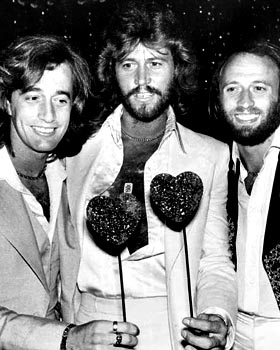Bee Gees
The Bee Gees were among the most successful vocal groups in pop music, beginning as young followers of the lush, tuneful sounds of the Beatles in the 1960s, then flourishing as champions of disco in the '70s. Their love songs were fueled on recognizable three-part harmonies and elegant hooks, with sales of more than 120 million albums worldwide.
The progeny of English bandleader Hugh Gibb, the brothers were born on the tiny Isle of Man and spent their earliest years in Manchester before moving with their family to Brisbane, Australia, in 1958. Barry (b. Sept. 1, 1946) and fraternal twins Robin (Dec. 22, 1949 - May 20, 2012) and Maurice (Dec. 22, 1949 - Jan. 12, 2003) teamed up as a trio of child singers, with frequent appearances on Australian television and at public events.
After a minor hit with the 1965 single “Wine and Women,” the Bee Gees began releasing albums and singles, topping the charts with “Spicks and Specks” the following year. The trio returned to England, where the Gibbs' first international hit was “New York Mining Disaster 1941,” reaching No. 14 on the American pop singles chart in 1967. Many hits followed through that decade, built from melodic flair if not content.
In 1969, Robin left for a solo career, while Barry and Maurice recorded “Cucumber Castle” (the duo depicted on the album cover as heroic knights in armor). The Bee Gees reunited as a trio in time for the pop hits “Lonely Days” and “How Can You Mend a Broken Heart” (a No. 1 single in 1971). The hits soon evaporated, and Bee Gees records were little noticed until the platinum album “Main Course” in 1976. Recorded in Miami with producer Arif Mardin, it had fewer ballads and more R&B, with the comeback singles “Jive Talkin'” and “Nights on Broadway” setting the stage for what was to come.
The trio became superstars with the release of the film “Saturday Night Fever,” starring John Travolta, which featured several original new Bee Gees songs that dominated the airwaves and the many discos sprouting up across the world. The band provided the chart-topping “Stayin' Alive,” “Night Fever” and “How Deep Is Your Love” to the soundtrack. On the album was also “If I Can't Have You,” written by the Bee Gees but sung by Yvonne Elliman, also a No. 1 hit. The brothers Gibb dominated the pop charts in 1977.
A backlash is inevitable against any band that omnipresent, but the Bee Gees also helped it along. A misguided film translation of the Beatles' classic “Sgt. Pepper's Lonely Hearts Club Band,” with the Gibbs and Peter Frampton stepping in for the Beatles, was a critical and popular disaster for all involved. The Bee Gees did enjoy another No. 1 album with 1979's “Spirits Having Flown,” including three chart-topping singles: “Love You Inside Out,” “Tragedy” and “Too Much Heaven.”
The 1980s would be a mostly fallow period for the band in the U.S., though Barry scored two top 10 hits in duets with Barbra Streisand: “What Kind of Fool” and “Guilty.” Internationally, the Bee Gees were still stars.
Younger brother Andy Gibb, who enjoyed success as a singer and actor in the '70s and occasionally appeared with the Bee Gees, died of heart failure in 1988 after years of substance abuse. The Bee Gees returned in 1989 with their best-reviewed album in years, the melancholy “One.” The title song was an American top 10 hit, though it fared less well internationally. More successful was 1997's “Still Waters,” their 19th album, recorded with several top producers, including Mardin and David Foster.
In 1997, they were inducted into the Rock and Roll Hall of Fame. Maurice died of heart failure in 2003, abruptly sidelining the group, though the surviving Gibbs have promised to return.


Five thoughts about Bee Gees
Share a thought about Bee Gees